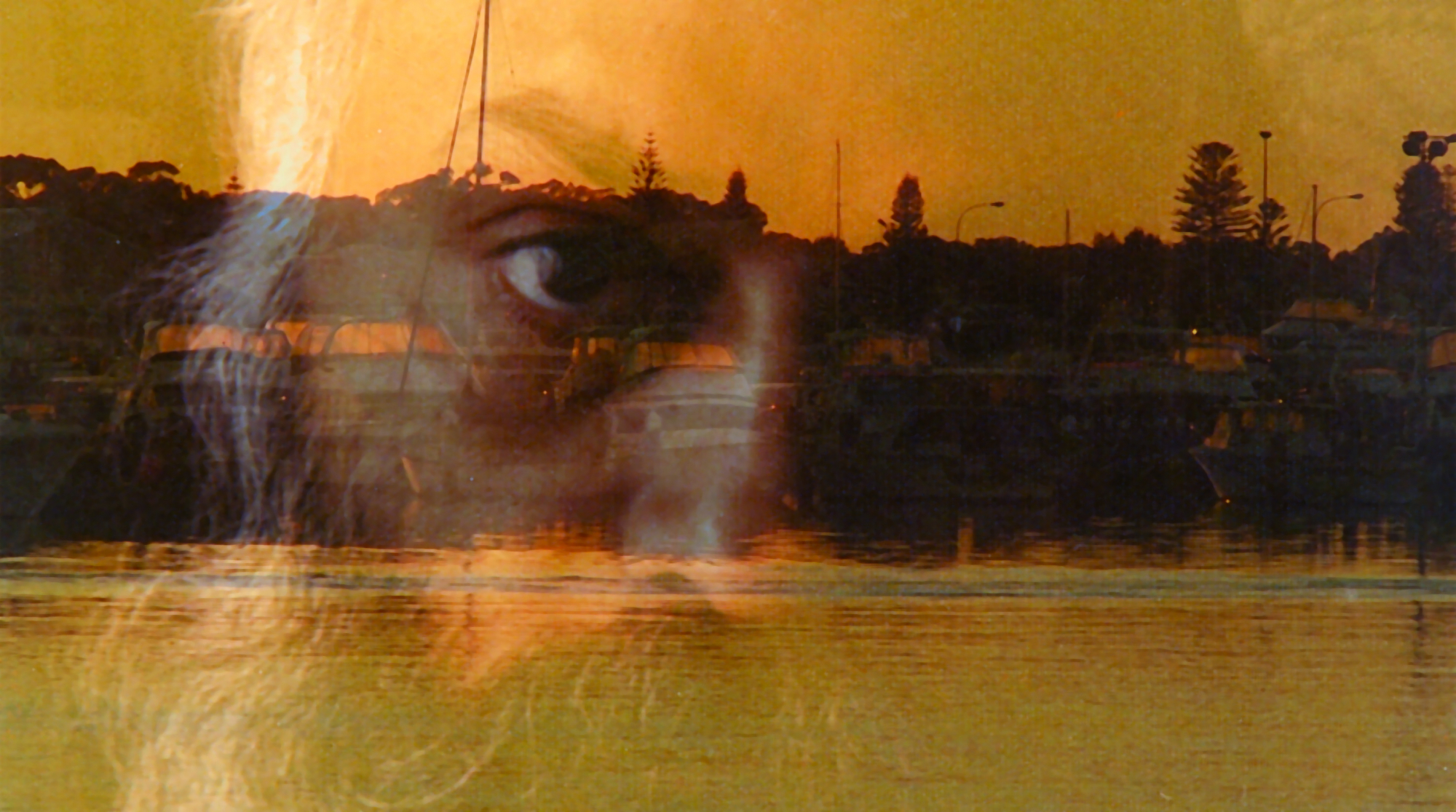Perhaps the presence of the harbour’s cranes, the ships entering and departing, the trains squealing through the perimeters of the town, and of course the ocean and its infinite horizon, are responsible for instilling in me a suspicion that there is more to observable reality than what might be immediately apparent.
– Joseph London[1]Joseph London, ‘The Beloved: A Documentary Film on the History and Aftermath of Fremantle’s Rajneesh Sannyasin Community – and – Hidden Realities: Transcendental Structures in Documentary Film: An Exegesis’, PhD thesis, Edith Cowan University, Perth, 2018, p. 134, available at <https://ro.ecu.edu.au/cgi/viewcontent.cgi?article=3132&context=theses>, accessed 23 January 2022.
In his 2013 apocalyptic thriller These Final Hours, Perth-born[2]See Travis Johnson, ‘These Final Hours’, X-Press Magazine, 29 July 2014, <http://xpressmag.com.au/these-final-hours-2>, accessed 20 January 2022. writer/director Zak Hilditch portrays his city as literally the last place on Earth, soon to be swept away by a tsunami of flame that has engulfed the rest of the planet. Hope of escape is non-existent, but this doesn’t stop Nathan Phillips’ boofhead hero from racing to redeem himself and reconcile with his ex (played by Jessica De Gouw) before the clock runs out.
I thought of These Final Hours while watching another remarkable film by a Western Australian about his home town: Joseph London’s epic meditative documentary The Beloved (2020), which centres on the port city of Fremantle, at the mouth of the Swan River within the Perth metropolitan area. Both films emphasise the isolation of this part of the world, which appears in each case to follow its own independent timeline, though the effect is achieved by opposite means. In These Final Hours, Perth becomes the locus of what future remains for humanity, condensed into a single diegetic day chronicled over an hour-and-a-half. In The Beloved, by contrast, a history with no clear beginning or end unfolds very gradually over more than four hours, viewed from a Western Australian perspective even though most of the crucial events occurred elsewhere.
The history in question concerns the Indian mystic Bhagwan Shree Rajneesh, known to the English-language media as the ‘sex guru’ or the ‘Rolls-Royce guru’[3]See, for example, Marina Manoukian, ‘The Story Behind the Largest Bioterrorist Attack in U.S. History’, Grunge, 15 March 2021, <https://www.grunge.com/355888/the-story-behind-the-largest-bioterrorist-attack-in-u-s-history/>, accessed 7 February 2022. and to his current followers as ‘Osho’, the name he adopted shortly before his death in 1990.[4]‘Osho’ meditation centres still exist around the world; the flagship ashram in Pune was a popular tourist destination both for Indians and international visitors up until the start of the COVID era. Rajneeshee communes were also said to exist as recently as 2018, including in Australia in the Byron Bay area. See Prachi Bari, ‘Osho International Foundation Submits Clarification to Governor on Sale of Ashram Properties’, Hindustan Times, 5 July 2021, <https://www.hindustantimes.com/cities/others/osho-international-foundation-submits-clarification-to-governor-on-sale-of-ashram-properties-101625463428019.html>; and Tom Cowie, ‘Wild Wild Country: Australian Tells of Life on Rajneesh “Sex Cult” Commune’, The Sydney Morning Herald, 19 May 2018, <https://www.smh.com.au/national/wild-wild-country-australian-tells-of-life-on-rajneesh-sex-cult-commune-20180519-p4zgal.html>, both accessed 20 January 2022. London is far from the first filmmaker to take an interest in the Rajneesh movement, recently made famous again by the six-part 2018 Netflix documentary series Wild Wild Country. The series is a brilliantly orchestrated piece of storytelling, making the most of the dramatic and even melodramatic aspects of the material: the flamboyant yet cryptic personality of Rajneesh himself, and the spectacular collapse of Rajneeshpuram, the ashram-commune he and his followers founded in 1981 after relocating from the Indian city of Pune to a ranch just outside the small town of Antelope, Oregon.
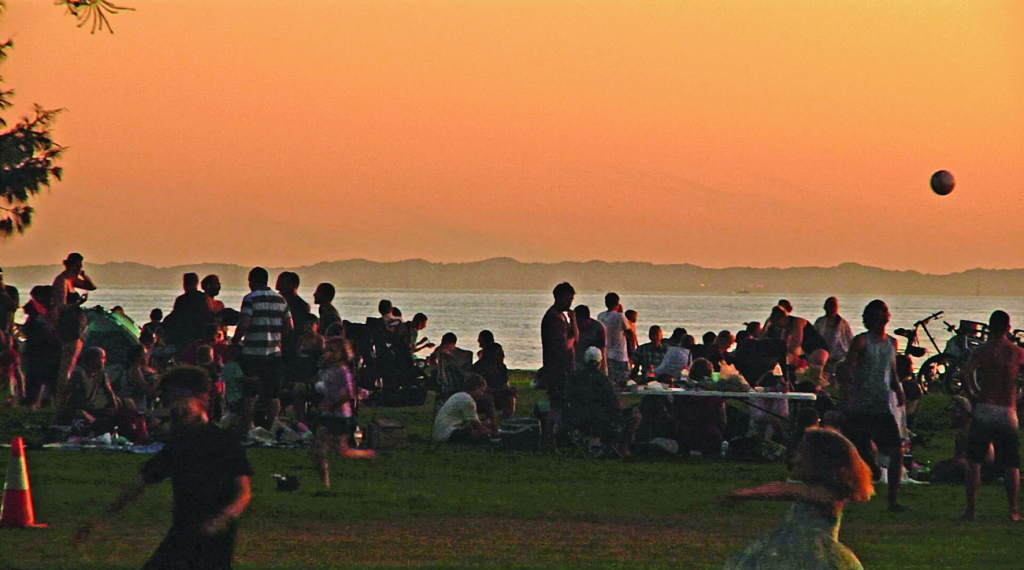
As Wild Wild Country recounts, tensions soon arose between Antelope locals and Rajneesh’s disciples, who referred to themselves as sannyasins (from a Sanskrit term meaning ‘ascetic’) and were nicknamed ‘the orange people’ for their distinctively coloured robes. Mainly white, university-educated baby boomers from the US and other English-speaking countries,[5]See Harry Aveling, ‘Introduction’, in Aveling (ed.), Osho Rajneesh & His Disciples: Some Western Perceptions, Motilal Banarsidass Publishers, Delhi, 1999, pp. xxx–xxxi. these true believers flocked to Rajneeshpuram in their thousands, threatening to become a political force across the county or even the state. Finally, in 1985, the whole enterprise came apart following a rift between Rajneesh and his personal secretary, Ma Anand Sheela, who would subsequently be jailed for her many jaw-dropping crimes, including a large-scale poisoning campaign that by pure good fortune resulted in no actual deaths.[6]See Win McCormack, ‘The Rise and Fall of the Rajneesh Cult’, The New Republic, 12 April 2018, <https://newrepublic.com/article/147955/rise-fall-rajneesh-cult>, accessed 7 February 2022.
Despite the worldwide reach of the Rajneesh movement, Wild Wild Country is a self-consciously American story, inviting us to choose between brands of gung-ho individualism: ornery conservatives in one corner, rambunctious hippies in the other. As its title hints, the show can even be understood as a literal western, albeit one that inverts the usual logic of the genre, with the residents of Antelope – again, a predominantly white community – cast as ‘natives’ resisting encroachment on their turf. All this exemplifies the kind of conflict-driven storytelling associated with both ‘balanced’ journalism and Hollywood melodrama, in which individuals aligned with ‘categorically entrenched positions’,[7]London, op. cit., p. 117. as London puts it, are pitted against one another for maximum entertainment value.
The Beloved can’t be considered a ‘response’ to Wild Wild Country, given how close London’s film was to completion when the show aired.[8]London had been working on The Beloved for several years and already had a rough cut prepared prior to the Netflix series’ launch. Editor correspondence with Joseph London, 14 February 2022. Still, something can be learned from a comparison between the two works, which approach the same terrain from radically different angles. Just as Wild Wild Country is an American story, The Beloved is an Australian one – and though some Australian sannyasins did make it to Oregon, London’s primary focus is on the smaller-scale ashram-commune set up in the same period in central Fremantle, with funding from a newly converted local sheep farmer.[9]London, op. cit., p. 103. Unlike their American counterparts, the dancing, smiling ‘orange people’ of Fremantle were on the whole regarded by their fellow citizens as an odd but benign phenomenon, a source of literal ‘local colour’.
Or so The Beloved indicates. But part of what’s distinctive about London’s approach is that he makes no pretence of giving us anything like the full story: to start with, he has erased all traces of his own presence from the film, including the questions he originally posed to his interviewees. Nor does he purport to balance opposing points of view; except in the archival footage that occupies a fraction of the running time, the only audible voices in the film belong to Australian sannyasins and ex-sannyasins (around two dozen in all). Up until near the end of this very long film, these speakers are heard without being seen, and when they show themselves at last, they’re all filmed in the same way: silently looking into the camera, motionless aside from their breathing in and out.
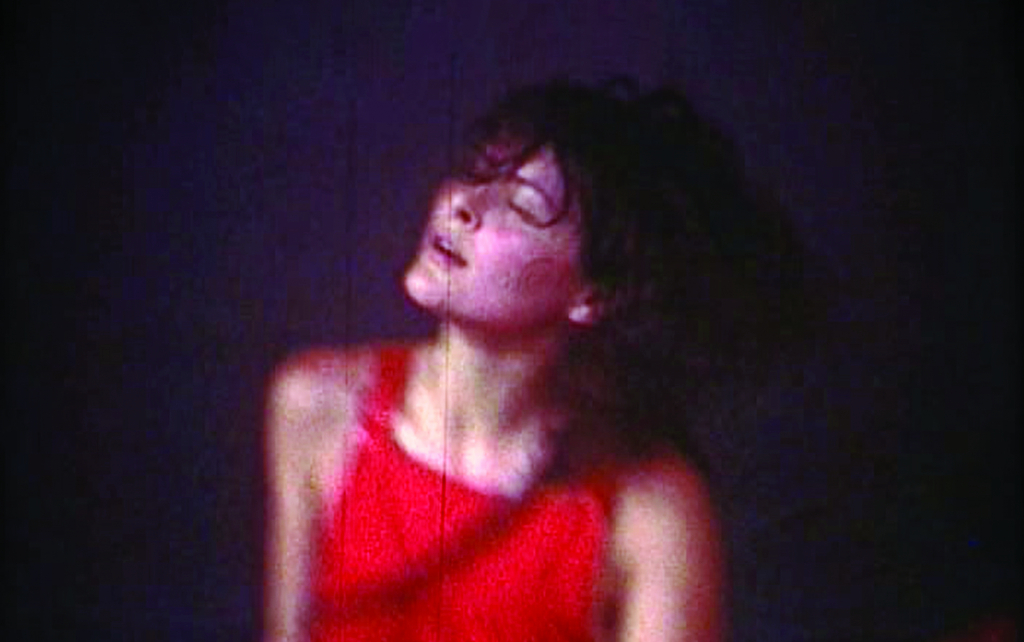
Prior to this, The Beloved has been dominated visually by wide shots of Fremantle, filmed by London himself in recent times: streets, parks, railway lines, the bay, with human figures either absent or set at a distance. For the most part, it’s up to us to discern what, if anything, links these specific images with what we’re hearing on the soundtrack; the Fremantle Trades Hall, for instance, which once housed the sannyasin commune, appears as one ‘heritage’ building among others.
To get a sense of the thinking behind this approach, we can turn to the exegesis that originally accompanied London’s film, the two together comprising the PhD thesis he submitted in 2018. Here, he draws on critics and thinkers as varied as André Bazin, Paul Schrader and Gilles Deleuze, all of whom in his view
have identified a cinema of a double nature: on one level, explicit in its narrative programme and engagement, while on another level, simultaneously registering a spatial and temporal ‘beyond’ that invites an alternative experience based on a formal engagement.[10]ibid., p. ii. Emphasis in original.
London terms this ‘transcendental structure’, while – importantly – spelling out that the term ‘transcendental’ for him need not imply ‘religious’ or even ‘spiritual’.[11]ibid., p. 13. That is, the ‘beyond’ that escapes definition may be less a higher realm than a traumatic black hole, as it surely is in Claude Lanzmann’s Shoah (1985), one of the ‘transcendental’ documentaries London cites as exemplary.[12]ibid., pp. 89–97. Or it may be both at once, as it appears to have been for certain sannyasins, some of whom may have fled their own traumatic histories only to wind up replaying them via the elusive Rajneesh and the harsh Sheela (the former never came to Fremantle in person, while the latter’s disastrous 1985 visit[13]See Kent Acott, ‘Tough Titties: The Fall and Rise of a Controversial Woman of the 80s’, The West Australian, 8 October 2016, <https://thewest.com.au/news/australia/tough-titties-the-fall-and-rise-of-a-controversial-woman-of-the-80s-ng-ya-116927>, accessed 8 February 2021. was a moment of disillusionment for many). Several of London’s subjects also express deep unease about the treatment of children within the Fremantle commune and elsewhere, while stopping short of specific allegations of abuse.
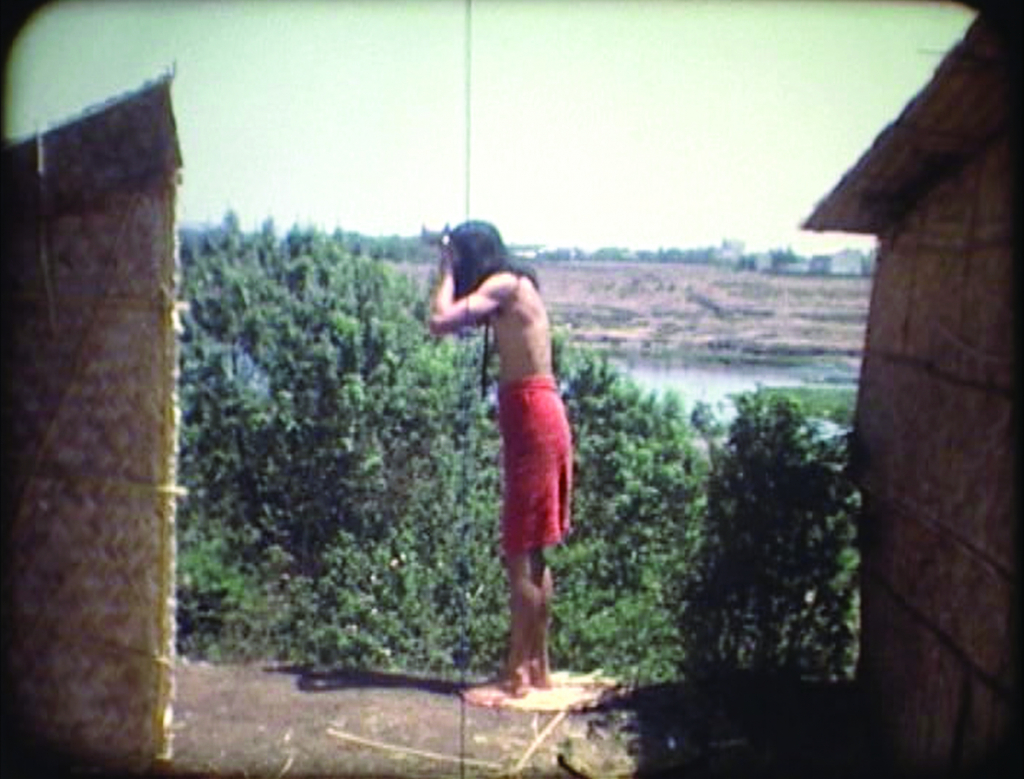
Though London doesn’t employ it in his exegesis, another theoretical concept useful for analysing the form of The Beloved is the ‘chronotope’, a term used by the Soviet literary critic Mikhail Bakhtin to refer to the set of ‘temporal and spatial relationships’ governing the form of a given genre.[14]Mikhail Bakhtin, in Michael Holquist (ed.), The Dialogic Imagination: Four Essays by M.M. Bakhtin, trans. Caryl Emerson & Holquist, University of Texas Press, Austin, TX, 1981, p. 84. Complex chronotopes are common enough in documentary to be taken for granted: Wild Wild Country, for instance, shifts continually between footage from the 1980s and present-day talking heads. By contrast, The Beloved relies primarily, though not exclusively, on newly filmed and recorded material – aiming, like Lanzmann in Shoah, to convey a sense of the past both as unreachable and as materially persisting into the present.
The Beloved relies primarily, though not exclusively, on newly filmed and recorded material – aiming, like Lanzmann in Shoah, to convey a sense of the past both as unreachable and as materially persisting into the present.
Where Lanzmann excluded all archival material on principle from his study of the Holocaust, London has explained that his choice to forgo talking heads was arrived at by trial and error during editing: ‘I found that the dream-space was punctured, and there was no going back to the same level or kind of immersion.’[15]London, op. cit., p. 131. Another of his strategies for maintaining this ‘dream-space’ was to blur the boundaries between different types of visual material, as in his use of slow dissolves when transitioning in and out of archival photographs.[16]ibid., p. 127. In his newly filmed images of Fremantle, he achieves a comparable effect by alternating between the sharp shadows of midday and the halftones of dawn and dusk, as if to illustrate the title of a recent history of Western Australia: Land of Vision and Mirage.[17]See Geoffrey Bolton, Land of Vision and Mirage: Western Australia Since 1826, University of Western Australia Press, Crawley, WA, 2008.
A similar blurring is evident in the overarching narrative of The Beloved, which is far less clearly shaped than the ‘classical’ rise-and-fall arc of Wild Wild Country (which Sheela, the show’s star performer, compares to grand opera). While for some of London’s interviewees the story has long concluded, others are sannyasins still, even without their distinctive dress; they’ve melted back into the mainstream, exerting an unseen influence that could be imagined to permeate the whole of Fremantle and beyond. This theme bleeds over in turn into the film’s visual tonalities, with the orange robes that dominate many of the archival images mirrored in the present-day footage by the no less ubiquitous clouds of sunrise and sunset.
It’s as if, after all, nothing has really changed – an impression reinforced by London’s choice to have us encounter his subjects first and foremost as voices, which don’t age in the unmistakable way that faces and bodies do. This tempts us to understand ‘Fremantle time’ as all but eventless, especially as London’s images give no strong sense of how the city has physically evolved from the 1980s until now. Yet the notion that the ‘orange people’ have assimilated into the wider population is a highly loaded one, historically speaking – and, as in Wild Wild Country, equally complex historical ironies are apparent in the initial presentation of the Rajneeshees as conquerors annexing territory on behalf of a global movement. Adding yet another level of meaning are the recurrent shots of Fremantle’s West End, with its limestone buildings preserved from the convict era – and while there may be fewer traces of the overlapping history of Indigenous dispossession, Australian viewers cannot fail to be aware that this has left a traumatic legacy of its own.
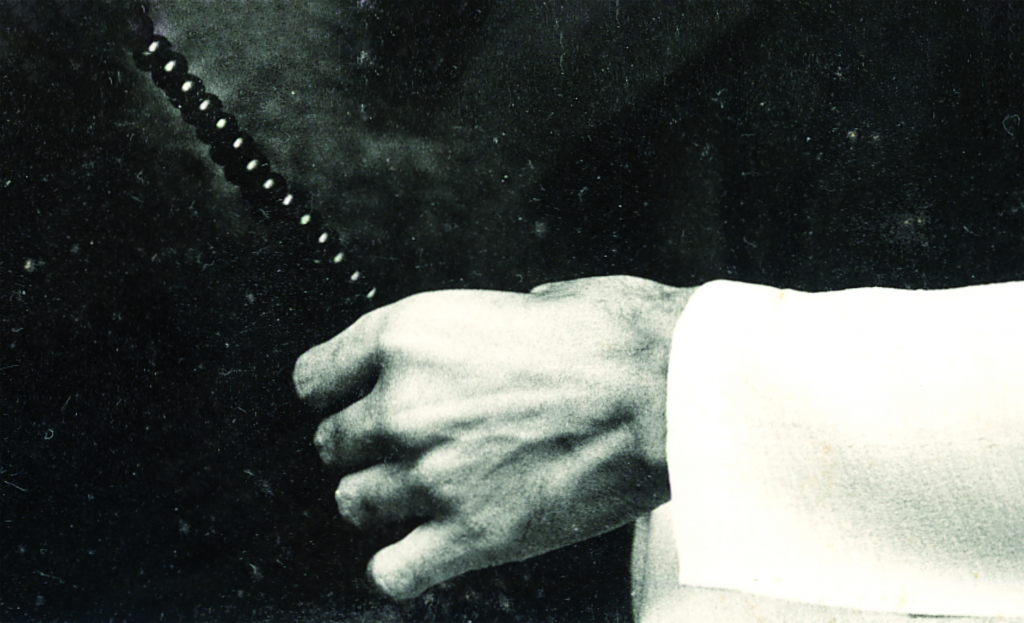
If there were a central conflict underpinning The Beloved, it might be a clash between two chronotopes, traditionally associated not just with works of art but with Western and Eastern religions respectively: the linear time of Christianity, culminating in apocalypse, versus the cyclical time of Hinduism and other faiths.[18]See Harold Coward, ‘Time in Hinduism’, Journal of Hindu-Christian Studies, vol. 12, 1999, pp. 22–7, available at <https://digitalcommons.butler.edu/cgi/viewcontent.cgi?article=1206&context=jhcs>, accessed 8 February 2022. If the former chronotope retains some influence over the narrative of The Beloved, the latter supplies yet another way of interpreting many of its individual shots, in which cycles are seen to unfold on multiple temporal scales. Birds circle above waves; a Ferris wheel turns; container ships embark on voyages across the planet. The challenge to linear history lies partly in the erasure of any felt distinction between the artificial and the natural, paralleled by the merging of traffic sounds with those of wind and water; the recurrence of motifs and locations across the film is yet another kind of cycle, reinforcing the lulling impression of movement without progress.
Of course, there’s a sense in which Fremantle is neither ‘West’ nor ‘East’ but somewhere else again – or nowhere in particular, rather in the same way that Rajneesh was paradoxically consistent in his refusal to align himself with any fixed doctrine. ‘I live in the moment,’ he characteristically remarked, ‘and whatsoever I am saying right now is true only for this moment.’[19]Bhagwan Shree Rajneesh, quoted in Hugh B Urban, Zorba the Buddha: Sex, Spirituality, and Capitalism in the Global Osho Movement, University of California Press, Oakland, CA, 2016, p. 26. If there could be such a thing as ‘Rajneesh time’, it would be neither linear nor cyclical, but a radical break from both past and future – and, therefore, in some sense, from temporality as such. Consolidating the paradox, this implies that self-contradiction is not really so contradictory, leaving loyal sannyasins scope to wonder how far their master really eschewed all forward planning, and how far he might have orchestrated Rajneeshpuram’s collapse as an object lesson for his disciples’ benefit.
That riddle aside, one lesson that viewers of The Beloved might absorb in turn is how readily opposites of all kinds collapse into one another. The absence of narrative can be its own kind of narrative; a refusal of movement is also an absolute break. Likewise, whatever is ‘transcendental’ in London’s film is inseparable from the ordinariness of its vision, evident not just in the images of mundane activity but in the very grain of the sannyasins’ voices: a succession of dry, quizzical, middle-class Australians of a certain generation, whose shared matter-of-factness both undercuts romantic notions of spirituality and testifies that what lured them in the first place was more than an airy-fairy dream. ‘I tried to tell her it was a load of crap, wanting to go to India. Why would you want to go to India? Dirt, dust and disease …’
In its location of mystery in the commonplace, the film may be aligning itself with the hard-won spiritual perspective of its interview subjects, who – geographically, at least – have circled back to somewhere near where they began. Or it may be negating the whole notion of a grand spiritual journey, implying that whatever you might have been seeking was always there in your own backyard. A jogger by the railway track, a suburban football game, a family barbecue near the ocean: if these things don’t carry ineffable meaning, what does? Even a functioning public transport system is its own sort of miracle: all that ingenuity, infrastructure and coordinated labour, ensuring that people day after day can arrive where they’re supposed to be.
What is most miraculous in The Beloved is the emergence of meaning from time to time as if of its own accord – so that, for instance, a shot of a man playing with his dog in the park may suddenly look like a precise illustration of what is being said on the soundtrack about the relationship between guru and disciple. How far such meanings are intended by London is not the point; if we set aside the religious connotations of the word ‘transcendental’, it might fairly be applied to the realm of meaning as such, which exists not on the screen but in the consciousness of the individual viewer. Faced with a shot of cars moving steadily along a motorway, we might feel that reality has always been like this, a matter of ebb and flow. Or we might be struck by the uncanniness of the image: as if humanity had faded from the picture without anybody noticing, and the machines had taken over.
Endnotes
| 1 | Joseph London, ‘The Beloved: A Documentary Film on the History and Aftermath of Fremantle’s Rajneesh Sannyasin Community – and – Hidden Realities: Transcendental Structures in Documentary Film: An Exegesis’, PhD thesis, Edith Cowan University, Perth, 2018, p. 134, available at <https://ro.ecu.edu.au/cgi/viewcontent.cgi?article=3132&context=theses>, accessed 23 January 2022. |
|---|---|
| 2 | See Travis Johnson, ‘These Final Hours’, X-Press Magazine, 29 July 2014, <http://xpressmag.com.au/these-final-hours-2>, accessed 20 January 2022. |
| 3 | See, for example, Marina Manoukian, ‘The Story Behind the Largest Bioterrorist Attack in U.S. History’, Grunge, 15 March 2021, <https://www.grunge.com/355888/the-story-behind-the-largest-bioterrorist-attack-in-u-s-history/>, accessed 7 February 2022. |
| 4 | ‘Osho’ meditation centres still exist around the world; the flagship ashram in Pune was a popular tourist destination both for Indians and international visitors up until the start of the COVID era. Rajneeshee communes were also said to exist as recently as 2018, including in Australia in the Byron Bay area. See Prachi Bari, ‘Osho International Foundation Submits Clarification to Governor on Sale of Ashram Properties’, Hindustan Times, 5 July 2021, <https://www.hindustantimes.com/cities/others/osho-international-foundation-submits-clarification-to-governor-on-sale-of-ashram-properties-101625463428019.html>; and Tom Cowie, ‘Wild Wild Country: Australian Tells of Life on Rajneesh “Sex Cult” Commune’, The Sydney Morning Herald, 19 May 2018, <https://www.smh.com.au/national/wild-wild-country-australian-tells-of-life-on-rajneesh-sex-cult-commune-20180519-p4zgal.html>, both accessed 20 January 2022. |
| 5 | See Harry Aveling, ‘Introduction’, in Aveling (ed.), Osho Rajneesh & His Disciples: Some Western Perceptions, Motilal Banarsidass Publishers, Delhi, 1999, pp. xxx–xxxi. |
| 6 | See Win McCormack, ‘The Rise and Fall of the Rajneesh Cult’, The New Republic, 12 April 2018, <https://newrepublic.com/article/147955/rise-fall-rajneesh-cult>, accessed 7 February 2022. |
| 7 | London, op. cit., p. 117. |
| 8 | London had been working on The Beloved for several years and already had a rough cut prepared prior to the Netflix series’ launch. Editor correspondence with Joseph London, 14 February 2022. |
| 9 | London, op. cit., p. 103. |
| 10 | ibid., p. ii. Emphasis in original. |
| 11 | ibid., p. 13. |
| 12 | ibid., pp. 89–97. |
| 13 | See Kent Acott, ‘Tough Titties: The Fall and Rise of a Controversial Woman of the 80s’, The West Australian, 8 October 2016, <https://thewest.com.au/news/australia/tough-titties-the-fall-and-rise-of-a-controversial-woman-of-the-80s-ng-ya-116927>, accessed 8 February 2021. |
| 14 | Mikhail Bakhtin, in Michael Holquist (ed.), The Dialogic Imagination: Four Essays by M.M. Bakhtin, trans. Caryl Emerson & Holquist, University of Texas Press, Austin, TX, 1981, p. 84. |
| 15 | London, op. cit., p. 131. |
| 16 | ibid., p. 127. |
| 17 | See Geoffrey Bolton, Land of Vision and Mirage: Western Australia Since 1826, University of Western Australia Press, Crawley, WA, 2008. |
| 18 | See Harold Coward, ‘Time in Hinduism’, Journal of Hindu-Christian Studies, vol. 12, 1999, pp. 22–7, available at <https://digitalcommons.butler.edu/cgi/viewcontent.cgi?article=1206&context=jhcs>, accessed 8 February 2022. |
| 19 | Bhagwan Shree Rajneesh, quoted in Hugh B Urban, Zorba the Buddha: Sex, Spirituality, and Capitalism in the Global Osho Movement, University of California Press, Oakland, CA, 2016, p. 26. |
